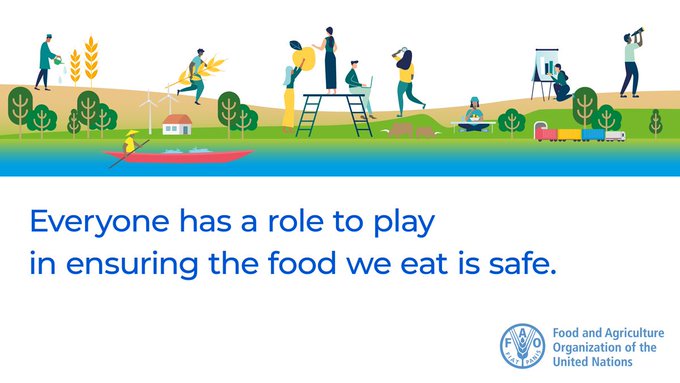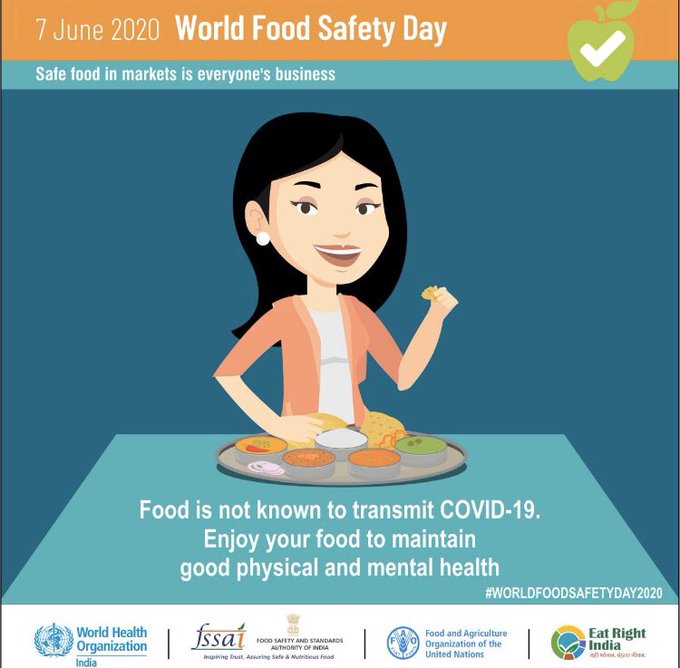Jun 7, 2020
World Food Safety Day: WHO Shares 5 Keys To Safer Food
World Food Safety Day: According to WHO, 1 in 10 people fall ill every year from eating contaminated food. Here are five easy ways to practice food safety.

World Food Safety Day: Practice these five measures for food safety by WHO.
Highlights
- World Food Safety Day is being celebrated on 7th June
- WHO has shared a number of guidelines for food safety
- FSSAI has also assured there is no risk of Covid-19 spread through food
There has been a heightened concern around food safety due to the onset of the Coronavirus epidemic. People are refraining from ordering food from restaurants, and venturing out solely for the purpose of eating. There is an increased preference for eating food that is home-cooked, and seemingly safer. Keeping the epidemic aside, unsafe food in general can cause over 200 diseases as per the WHO. According to the World Health Organisation, 1 in 10 people fall ill every year from eating contaminated food and 4,20,000 die each year as a result across the globe.
DYK: 1 in 10 people fall ill every year from eating contaminated food and 420,000 die each year as a result.
Children under-5 are at particularly high risk. 125,000 young children die from foodborne diseases every year.https://bit.ly/2U7JRM0 #FoodSafety
392 people are talking about this
In a bid to debunk the myths associated with food safety and to ensure that the food we are eating is safe, the WHO has shared five keys to safer food. These come ahead of World Food Safety Day being celebrated on 7th June, 2020. These are easy guidelines that can be adhered to in these testing times. With these five practices by your side, the safety of your food can be rest assured and you do not have to worry about contracting infections or diseases through your food.
Here Are Five Keys To Safer Food By WHO:
1. Keep Clean
Before we enter the kitchen, it is vital to wash hands and ensure cleanliness and hygiene at all times while cooking.
2. Separate Raw & Cooked Food
It is a good idea to keep raw food in different containers vis-a-vis the cooked ones. This will prevent any risk of contamination for either of the two.
3. Cook thoroughly
Food must be cooked thoroughly and properly before being served, in order to kill any germs and enhance the nutrition too.
4. Keep food at safe temperatures
Different kinds of foods need to be stored differently, location and temperature-wise too. Make sure you follow these practices to ensure safety of food.
5. Use safe water and safe raw materials
The cooking processes should spic and span, as should the raw ingredients and materials. Use safe water and raw materials at all times. Take a look at the full video here:
Unsafe food can cause over 200 diseases.
Do you know the fiveto #SafeFood?
Keep clean
Separate raw & cooked food
Cook thoroughly
Keep food at safe temperatures
Use safe water & safe raw materials #FoodSafety#WorldFoodSafetyDay
19 people are talking about this
Apart from the guidelines for food safety by WHO, a number of safety measures can be ensured in the process of producing food as well. The Food and Agricultural Organisation (FAO) tweeted about the food safety process, which begins right at the farm and ends with the consumption of the food. It is vital to maintain good standards of food safety at all stages of this process.
Everyone has a role to play in ensuring the food we eat is safe.
Learn more about food safety and qualityhttps://bit.ly/2TTJDIh #WorldFoodSafetyDay
40 people are talking about this
As for the major concern surrounding food safety in the Covid-19 times, the Food Safety and Standard Authority India (FSSAI) has issued a clarification. "There is no scientific evidence to indicate the transmission of #COVID19 through food," said the organisation on their Twitter handle.
There is no scientific evidence to indicate the transmission of #COVID19 through food.#WorldFoodSafetyDay #FoodSafety #SafeFood@WHOSEARO @WHO @FAOWHOCodex
26 people are talking about this
The clarification comes ahead of the reopening of restaurants on June 8, wherein they will be maintaining the utmost hygiene standards and practices to assure customers. We hope to see more strides in the direction of food safety in future as well!
Is The Food On Your Table Safe To Eat?
On World Food Safety Day, it is important to remember that unsafe food practices claim approximately 4,20,000 lives annually across the world. According to the World Health Organisation, 1 out of 10 people fall ill after consuming contaminated food worldwide each year.

Food is a basic necessity of life, along with clothing and shelter, yet poverty deprives millions of people from accessing clean and hygienic food.
India is blessed with natural resources and abundance of raw materials. However, salubrious food is still a luxury for many Indians. With an abysmally low score of 30.3 on the Global Hunger Index of 2019 - India dropped from 97 out of 118 countries in the Global Health Index in 2016 to 102 out of 117 nations in 2019.
The COVID-19 pandemic has kicked poor people right in their stomachs, leaving them reeling between seasonal hunger and chronic hunger. With the extended lockdown and economic slowdown, their situation seems to be worsening by the day. As days turn into weeks, the growling of their empty stomachs is getting louder, and their despair and desperation has to led to children being forced to scavenge for food or leftovers in garbage dumps.. WHO estimates that nearly 30 % of food borne deaths occurs among children under 5 years of age.
The second World Food Safety Day (WFSD) is being marked today (June 7) after the first event stirred the conscience of the world. Last year, the United Nation General Assembly adopted a resolution to promote food safety everywhere. This year too, it seeks to draw attention and inspire action to help, prevent, detect, and manage food borne risks, contributing to food security, human health, economic prosperity, agriculture, market access, tourism, and sustainable development.
Due to the pandemic, the event -- including discussions, webinars, will be conducted online and promoted on social media with hashtags like 'World Food Safety Day,' and 'WFSD.'
The objective is to strengthen and ensure food safety for everyone, irrespective of their financial or social status, caste, religion, gender or ethnicity. Food is a fundamental right for all humans, and access to nutritious diet has a direct impact on the growth of every nation.
Safety First
From farm to frying pan, and then to our dining tables, the food we consume comes to us after exposure and contact with different surfaces and hands. This often leads to cross-contamination, where dangerous bacteria gets transferred from a contaminated source to the food. Therefore, care is required at every step till the food reaches the table. A research study found that food borne diseases are expected to rise from 100 million in 2011 to 150-177 million, by 2030. Affluent and urban households are more likely to be affected due to the high consumption of meat and processed food.
As per a 2019 report published in the journal 'Lancet' - India ranks second after China in terms of 'poor diet,' leading to a terrible death toll (1,573,595). The shocking fact is that the
inadequate and unhealthy diet of poor migrants or laborers is due to their financial constraints, many urban people choose this diet, knowingly and sometimes unknowingly.Blessed are those who get to eat three square meals a day, while millions go to bed hungry and suffer from chronic malnourishment.
The Integrated Disease Surveillance Program of the Indian Ministry of Health & Family Welfare-warns that incidents of food poisoning is becoming increasingly common across the country.
Sharing and Caring -
Food safety is a shared responsibility between governments, producers, and consumers, where everybody plays a key-role in ensuring awareness towards food safety. With the onset of WFSD, WHO calls upon countries to join hands together and reduce the burden globally.
Here are some simple yet effective steps we can take to ensure that the food we eat is safe
1. Cleanliness: A momentary negligence in cleaning can turn infection into a disease. Hence, wash your hands, kitchen countertops, cooking ware, and everything thoroughly. Wash, rub, rinse, and disinfect every single surface, and 70% of the work is done.
2. Separate: Always separate raw meat from other food items, as the bacteria can cross contaminate easily via chopping boards or the cleaning cloth used while handling raw meat.
3. Cooking: Undercooked food is another major cause for food borne illnesses. Therefore, experts recommend that we cook food, especially meat or poultry, thoroughly to avoid any kind of contamination.
Subscribe to:
Comments (Atom)










